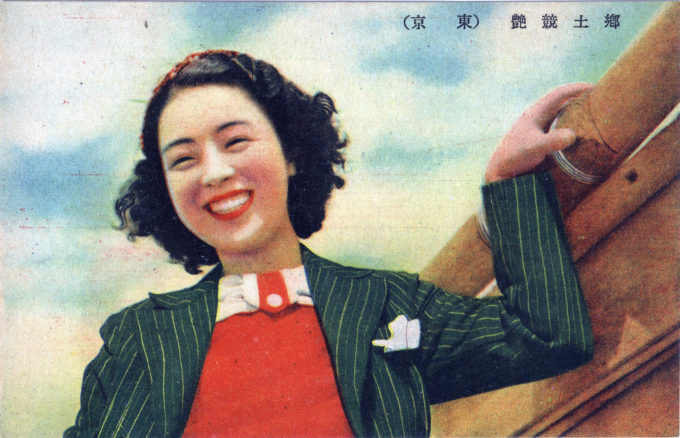
Nohonshugi (“agrarian fundamentalism”) propaganda postcard, c. 1940, captioned “郷土競艷” [“Bewitching beauty of the local area”]. Nohonshugi was first formulated as an ideology in the Meiji Period as a reaction against attempts to promote industry and commerce at the expense of agriculture. Romanticized by militant nationalists, who denounced industrialization, bureaucratization, and the “invasion” of Japan by foreign cultures, the movement in the 1930s became absorbed into the overall nationalist ideology and kokutai [“national essence”] that opposed the earlier liberal “Taisho democracy” of the 1920s.
See also:
Dai Nihon Kokubo-fujin (Greater Japan National Women’s Defense Association), c. 1940.
National Spiritual Mobilization Movement propaganda postcard, c. 1940.
“Solid nation union to sail in rough sea” propaganda postcard, c. 1940.
“Anytime!!” Preparations for invasion, propaganda postcard, 1945.
“[P]easants required no lectures on the virtues of thrift and diligence. These qualities were essential to their survival. Peasant families have traditionally insisted on not leaving a single grain of rice in their bowls. Unnecessary consumption was looked upon as a sinful action, and daily toil was held in particularly high regard.
“A number of political leaders supported the advocates of nohonshugi (‘agrarian fundamentalism’) to combat what the saw as the threat from ‘dangerous’ ideologies, that is, socialism and communism … One Japanese sociologist emphasized the moralistic aspects of the movement when he asserted that nohonshugi ‘indoctrinated farmers with the idea that agriculture was the most natural and wholesome of occupations and the key industry of the nation, and that urban industrialization was an important cause of moral degradation.’
“… Bureaucrats, initially seeing in the movement a possible means of relieving agrarian poverty, extolled the virtues of ‘frugality, duty, hard work, and the village economy as the backbone of the nation.’ But they soon seized instead upon expansion abroad as their solution to agrarian problems, with nohonshugi used as a vehicle to mobilize agrarian support for the policy. Most adherents of nohonshugi were hostile to big business and aligned themselves with radical militarists and militant nationalists who were bent upon effecting a new order, the Showa restoration, by ridding the nation of grasping capitalistic elements.
“… Nohonshugi thinkers had mystical notions about the Japanese national polity, and expected social harmony to be attained under the spiritual guidance of the emperor [kokutai] … The purity of the Japanese peasant soul, according to [nohonshugi ideologue] Kato Kanji, had been corrupted by economists influenced by ‘Western individualism and materialism.'”
– Peasants, Rebels, Women, and Outcastes: The Underside of Modern Japan, by Mikiso Hane, 2016

